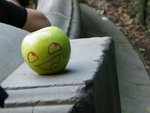- digital videos
- digital audio
- Digital phone calls
- digital photoes
- digital televison
The number system digital data is based on is the binary numeral system and the numbers used in this system are 1 and 0. The binary numeral system is a way to write lot's of different numbers using only 2 digits. Here are some examples:
1. 1
2. 10
3. 11
4. 100
5. 101
A bit is the smallest unit of information a computer can use. A group of 8 bits is called a byte.
A sampling rate is also called a sample rate. It's typically expressed in samples per second, the rate at which samples of an analog signal are taken to be converted into digital form. For example, a PC's sound card will sample a recieved analog signal, like through a microphone, and digitalise it for the computer. The higher the sampling rate the better the reproduction.
Colour depth is how many colours the monitor can display. The higher the colour depth (or the greater number of colours shown) the better the image quality will be because it will look more realistic and detailed.
This picture shows the difference in colour depth.
The sampling rate only affects video not still media (like photos) because still media doesn't involve sound. It's just like that colour depth doesn't affect the music you listen to because there's no pictures involved in music.



No comments:
Post a Comment